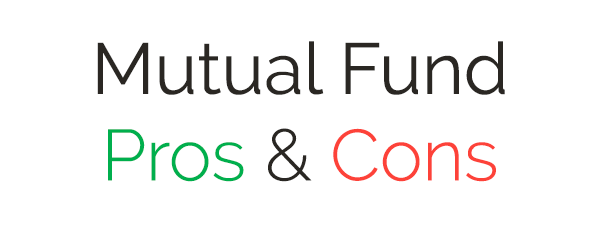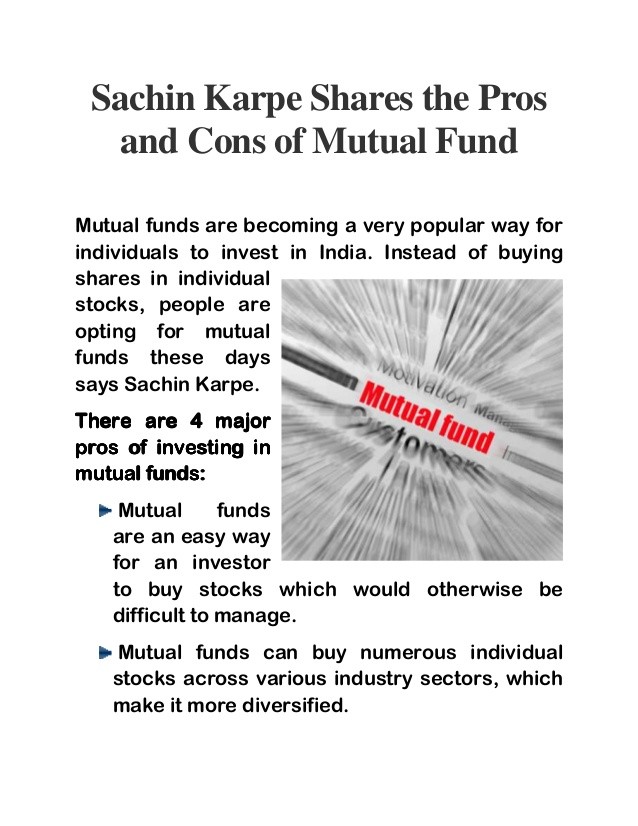The Pros and Cons of Mutual Funds
Post on: 6 Август, 2015 No Comment

Mutual funds are becoming a very popular way for individuals to own a piece of corporate America. Instead of buying shares in individual stocks, an investor buys shares in a mutual fund that, in turn, buys shares in individual stocks.
A mutual fund offers three key benefits over buying individual stocks:
- Diversification. Unless an investor hits the lottery or inherits a fortune, she probably doesn’t have the cash to buy stock from a large number of different companies. A mutual fund, however, has that much cash (from investments made by investors), and it uses the cash to buy large positions in a dozen or so companies. It’s hoped that if one or two companies don’t do too well, that will be more than offset by good performances by the others.
- Professional management. What’s a good stock to pick? When should your buy? When should you sell? You might not know the answers, but a professional should. Fund managers are experienced in investing.
- Liquidity. Any time the money is needed for something, shares in the mutual fund can be sold. There’s no guarantee that you’ll get what you put into the fund (it may be more or it may be less), but you’ll be able to cash out at your choosing.
Money ABCs
A mutual fund is a pool of money from many investors that’s invested in securities and managed by professionals.
Of course, for just about any benefit, there’s a cost involved. For example, fees and costs are involved in owning mutual funds. and there’s no government insurance or other protection to help investors if the price of the fund drops. Investors can lose some or all of their money in the funds, and they must bear this market risk all by themselves.
Making Money in Mutual Funds
As we’ve said, there are no guarantees. But with some savvy selections and a little patience, investors can reap big rewards from investing in stock mutual funds. Returns from these types of funds come about in several ways:
Piggybank on It
Capital gain distributions are given long-term capital gain treatment for income tax purposes. They’re eligible for the special capital gains tax rate of 20 percent (or 10 percent for those in the 15 percent tax bracket on their other income).

- Dividends. When the fund collects dividends on stock it owns, it passes these on to investors.
- Capital gain distributions. Funds may get capital gains when they sell a stock. They can pass these gains on to investors in the form of capital gain distributions.
- Capital gains from selling mutual fund shares. An investor who sells his shares in the fund at a profit can pocket capital gains.
When you add up these sources of income from a fund, you get a picture of a total return. This is really the increase in the value of the shares in the fund, taking into account a reinvestment of dividends and capital gain distributions, plus rises (or declines) in the price of the shares (in effect, paper gains or losses).
Income paid by a fund is reported to investors (and the IRS) on Form 1099-DIV. Use this information return for guidance on what to report for income tax purposes.
Money ABCs
No-load funds don’t charge any fees to buy or sell their shares, but no-load funds aren’t free. They have operating expenses that reduce returns to investors.
Piggybank on It
Just because a fund charges a load doesn’t make it a bad choice. It’s important to consider the fund’s overall performance. If a load fund does better than a no-load, an investor may be better off paying the fee to get that edge.
Fund Fees
You don’t get something for nothing, even with so-called no-load funds. Costs are involved in owning all types of mutual funds, including these:
- Load charges to buy shares. These are called front-end loads and can run between 4 percent and 8.5 percent of the funds being invested. (Low-load funds charge between 1 percent and 3 percent.) Shares with front-end loads are called A shares.
- Back-end loads to sell shares. Also called exit or redemption fees or contingent deferred sales charges (CDSCs), these are the opposite of front-end loads. These fees are charged to get out of the fund and are levied only on the amount invested, not on any reinvestments of dividends or capital gains or any appreciation in the value of the shares. However, they’re usually based on a sliding scale that disappears over time. For example, there may be a 5 percent back-end fee to sell the fund in the first year of ownership, but the fee may be reduced by 1 percent each year. Thus, if the shares are held more than five years, there’s no fee to sell. Shares with back-end loads are called B shares. Usually after B shares have been held beyond the specified time that the fees can be charged, they’re automatically converted to A shares.
- Expenses that the fund incurs in its operations. Operating fees to cover amounts paid to fund managers and expenses of buying and selling shares can range from 0.25 percent to more than 2 percent of a fund’s net assets. Some funds may waive some or all of their fees on a temporary basis for various reasons (for example, new funds may do this to improve the fund’s yield). There are also 12b-1 fees that relate to the cost of distributing fund shares. They’re called 12b-1 fees because of the section in the Securities and Exchange Commission rules that allow these fees to be charged back to investors. These 12b-1 fees are higher in B shares than in A shares.
Some funds also have C shares, D shares, and even T shares. The fees and charges on each class of shares differs, as explained in the prospectus. Which way does an investor come out better in the alphabet? Different funds are designed for different investment needs. Generally, long-term investors prefer B shares because all their money goes to work for them immediately. But there’s also the school of thought that A shares will result in lower costs over the long run. If your child’s investments in mutual funds are intended to pay for college expenses, keep in mind the time frame for when shares will have to be sold. For example, if you child is older than 12, it might not make sense to buy B shares because he’d have to pay surrender charges on a sale at college time.














